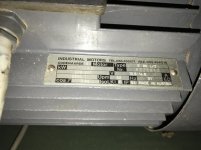S1 Continuous duty The motor works at a constant load for enough time to reach temperature equilibrium.
S2 Short-time duty The motor works at a constant load, but not long enough to reach temperature equilibrium. The rest periods are long enough for the motor to reach ambient temperature.
S3 Intermittent periodic duty Sequential, identical run and rest cycles with constant load. Temperature equilibrium is never reached. Starting current has little effect on temperature rise.
S4 Intermittent periodic duty with starting Sequential, identical start, run and rest cycles with constant load. Temperature equilibrium is not reached, but starting current affects temperature rise.
S5 Intermittent periodic duty with electric braking Sequential, identical cycles of starting, running at constant load and running with no load. No rest periods.
S6 Continuous operation with intermittent load Sequential, identical cycles of running with constant load and running with no load. No rest periods.
S7 Continuous operation with electric braking Sequential identical cycles of starting, running at constant load and electric braking. No rest periods.
S8 Continuous operation with periodic changes in load and speed Sequential, identical duty cycles run at constant load and given speed, then run at other constant loads and speeds. No rest periods.







